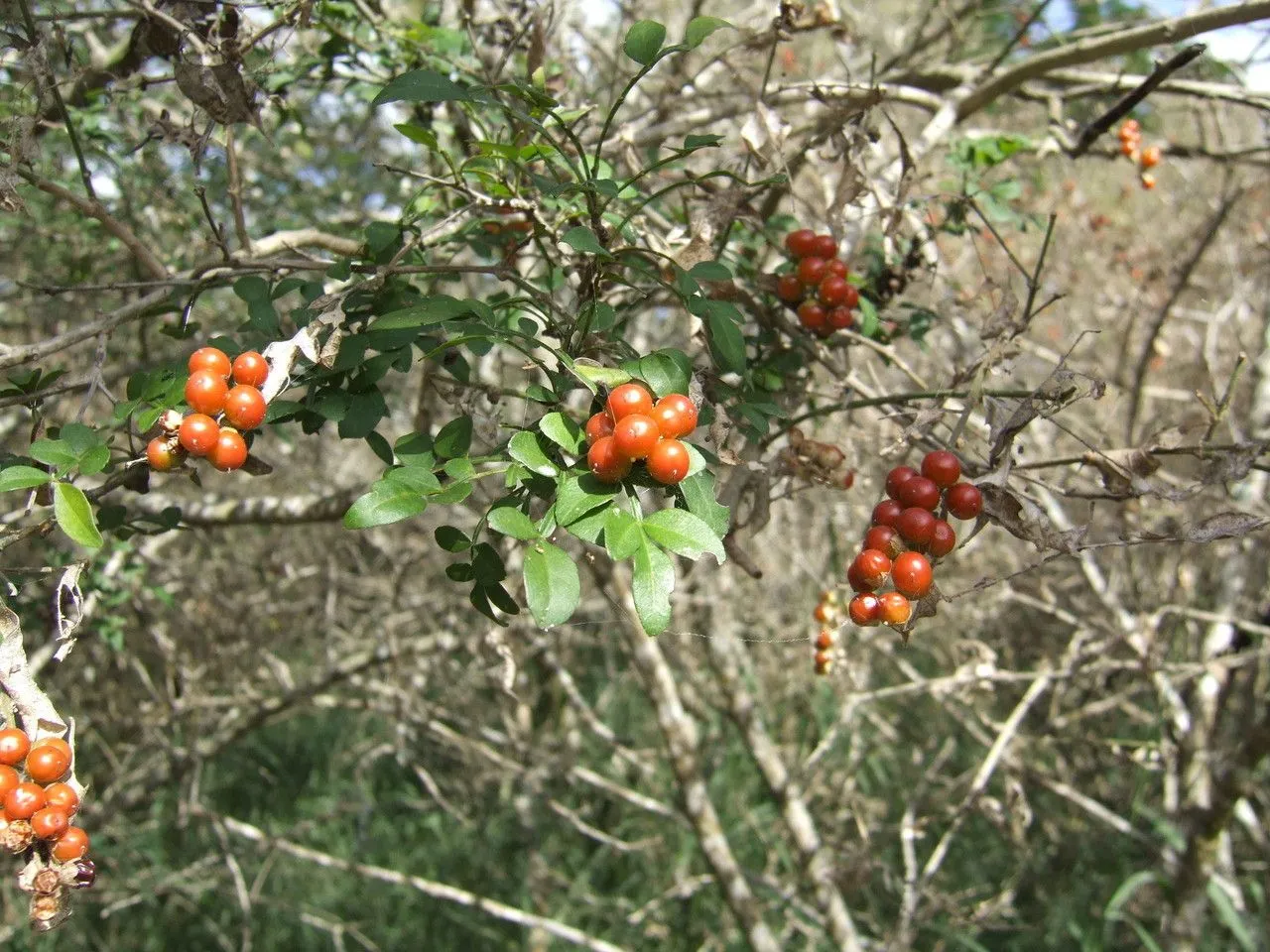
Author: (L.) Sarg.
Bibliography: Gard. & Forest 2: 186 (1890)
Year: 1890
Status: accepted
Rank: species
Genus: Zanthoxylum
Vegetable: False
Observations: Trop. & Subtrop. America
Lime prickly-ash, scientifically known as Zanthoxylum fagara, is a notable species belonging to the Rutaceae family. This plant has garnered attention particularly for its unique characteristics and adaptability to diverse climatic conditions, specifically thriving in tropical and subtropical regions across the Americas.
Originating from tropical and subtropical America, Lime prickly-ash has successfully established itself in various habitats, showcasing its resilience and adaptability. The plant is distinguished by its thorny branches and vibrant foliage. The leaves are typically composed of numerous small, glossy leaflets that emit a citrus-like fragrance when crushed, a trait that likely contributes to its common name.
The plant holds a particular significance within its native range. Zanthoxylum fagara not only adds to the ecological diversity of the regions it inhabits but also supports various forms of wildlife. Birds and insects are often drawn to its flowers and seeds, contributing to the ecological balance and promoting natural seed dispersal.
In addition to its ecological importance, Lime prickly-ash has been of interest for various practical applications. Historically, different parts of the plant have been used in traditional medicine by indigenous peoples. Its bark, leaves, and seeds have been utilized for their purported medicinal properties, including treatments for ailments such as digestive issues and pain relief.
One of the most compelling aspects of Lime prickly-ash is its adaptability. It demonstrates a remarkable ability to grow in a range of environmental conditions, from coastal areas to inland habitats. This versatility makes it a resilient species capable of surviving in less-than-ideal circumstances. The plant typically prefers well-drained soils and can often be found thriving in areas with adequate sunlight.
Zanthoxylum fagara was formally described and given its botanical nomenclature in an authoritative work published in “Gardener’s Chronicle & Agricultural Gazette” in 1890 by the botanist (L.) Sargent, which signifies its long-standing recognition in botanical literature.
In summary, Lime prickly-ash (Zanthoxylum fagara) is a remarkable plant species that contributes significantly to the biodiversity of tropical and subtropical regions in the Americas. Its adaptability, ecological roles, and historical uses make it an intriguing subject for further botanical and ecological studies.
Por: arruda-amarela, coentrilho, mamica-de-cadela, mamica-de-porca, mamica-de-porca-branca
Spa: colima, correosa, uña de gato
Eng: lime prickly-ash, lime pricklyash, wild lime, wild limetree
En: Lime prickly-ash, Wild lime, Wild limetree, Lime pricklyash, Limestone Prickly-Ash
Ar: فاغرة معروفة
El: Άγριο μοσχολέμονο
Pt: Arruda-amarela, Coentrilho, Mamica-de-cadela, Mamica-de-porca branca, Mamica-de-porca, Mamica-de-porca-branca
Es: Correosa, Colima, Uña de gato
Taken Dec 29, 2020 by aissar (cc-by-sa)
Taken Nov 26, 2020 by Maryline Laporte (cc-by-sa)
Taken Feb 20, 2021 by Juan Silvestre Pastor Molina (cc-by-sa)
Taken Nov 21, 2022 by coline jaunet (cc-by-sa)
Taken Nov 21, 2022 by coline jaunet (cc-by-sa)
Taken Nov 20, 2013 by EOL − Kenneth Bader (cc-by-nc)
Taken May 13, 2019 by Lusajo Mwakibinga (cc-by-sa)
Taken Jul 7, 2022 by Trap Hers (cc-by-sa)
Taken Feb 9, 2011 by EOL − Homer Edward Price (cc-by)
Taken Nov 6, 2014 by EOL − johnwilliams (cc-by-nc)
Taken Mar 14, 2015 by EOL − Tim Guida (cc-by-nc)
Taken Nov 20, 2013 by EOL − Kenneth Bader (cc-by-nc)
Taken Jul 7, 2022 by Trap Hers (cc-by-sa)
Taken Jul 28, 2022 by FUENTES LUIS (cc-by-sa)
Taken Nov 19, 2021 by agilob (cc-by-sa)
Taken May 11, 2021 by Silvia Fahmy (cc-by-sa)
Taken Aug 9, 2020 by Pascual David (cc-by-sa)
Taken Sep 17, 2022 by Tristan Jaton-Maria (cc-by-sa)
Taken Aug 6, 2021 by Muzzachiodi Norberto (cc-by-sa)
Taken May 11, 2021 by Silvia Fahmy (cc-by-sa)
© copyright of the Board of Trustees of the Royal Botanic Gardens, Kew.
© copyright of the Board of Trustees of the Royal Botanic Gardens, Kew.
© copyright of the Board of Trustees of the Royal Botanic Gardens, Kew.
Growth habit>: Tree, Shrub
Family: Myrtaceae Author: (F.Muell.) K.D.Hill & L.A.S.Johnson Bibliography: Telopea 6: 402 (1995) Year: 1995 Status:…
Family: Rubiaceae Author: Pierre ex A.Froehner Bibliography: Notizbl. Bot. Gart. Berlin-Dahlem 1: 237 (1897) Year:…
Family: Sapindaceae Author: Koidz. Bibliography: J. Coll. Sci. Imp. Univ. Tokyo 32(1): 38 (1911) Year:…
Family: Asteraceae Author: A.Gray Bibliography: Pacif. Railr. Rep.: 107 (1857) Year: 1857 Status: accepted Rank:…
Family: Fabaceae Author: Medik. Bibliography: Vorles. Churpfälz. Phys.-Ökon. Ges. 2: 398 (1787) Year: 1787 Status:…
Family: Aspleniaceae Author: (Cav.) Alston Bibliography: Bull. Misc. Inform. Kew 1932: 309 (1932) Year: 1932…